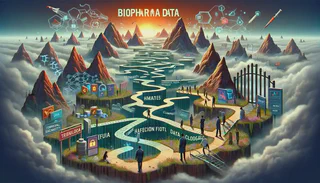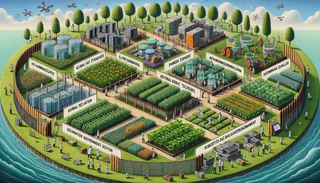
In the biopharmaceutical sector, the collection and analysis of data from diverse sources: clinical trials, real-world evidence (RWE), patient registries, and more—are fundamental to drug development, regulatory approval, and post-market surveillance. However, data from these sources often vary in format, nomenclature, and measurement standards, making it challenging to aggregate and analyse them effectively. Data harmonisation addresses these challenges by standardising disparate data for seamless integration, analysis, and interpretation.
In the dynamic landscape of biopharmaceutical research and development, the significance of data has never been more crucial. As advancements in technology continue to propel the industry forward, the volume and complexity of data generated have grown exponentially. In this context, the concept of data harmonisation emerges as a key driver for streamlining processes, enhancing collaboration, and ultimately accelerating the pace of innovation in the biopharma sector.
Data harmonisation refers to the process of integrating and standardising data from diverse sources to create a unified and consistent dataset. In the realm of biopharma, this involves bringing together information from various stages of drug discovery, development, and commercialisation, ensuring compatibility and coherence. The goal is to establish a cohesive framework that enables seamless data sharing, analysis, and interpretation across the entire pharmaceutical ecosystem. Overall, data harmonisation plays a pivotal role in enhancing the efficiency, reliability, and utility of data in the biopharmaceutical sector. By standardising disparate data sources and enabling seamless integration and analysis, data harmonisation empowers stakeholders to make informed decisions, drive innovation, and ultimately improve patient outcomes.

Historically, the biopharmaceutical industry has struggled with data silos and incompatible datasets, which have hampered efficient drug development and time-to-market. The early 2000s marked the beginning of concerted efforts to harmonise data, with initiatives focusing on standardising clinical trial data. Regulatory bodies like the FDA and EMA began emphasising the importance of data quality and integrity, prompting the industry to adopt data harmonisation practices.
The advent of electronic health records (EHRs) and advances in data technology have further underscored the need for harmonised data. Initiatives such as the Clinical Data Interchange Standards Consortium (CDISC) have developed standards like the Study Data Tabulation Model (SDTM) and the Analysis Data Model (ADaM), which are now widely adopted in clinical trials data management.
These standardised models provide a common framework for organising and formatting clinical trial data, enabling seamless integration and analysis across different studies and organisations. By adhering to CDISC standards, biopharmaceutical companies can improve data quality, facilitate regulatory submissions, and enhance interoperability with healthcare systems and research partners.
In addition to clinical trial data, efforts to harmonise real-world evidence (RWE) have gained momentum in recent years. Initiatives such as the Observational Medical Outcomes Partnership (OMOP) and the Patient-Centered Outcomes Research Institute (PCORI) aim to standardise and aggregate RWE from electronic health records, claims data, and patient registries. By harmonising RWE, researchers can generate insights into real-world treatment outcomes, patient populations, and healthcare utilisation, complementing traditional clinical trial data.
The evolution of data harmonisation in biopharma reflects a growing recognition of the importance of data interoperability, quality, and transparency in driving innovation and improving patient outcomes. As the industry continues to embrace digital transformation and data-driven approaches, the role of data harmonisation will only become more critical in unlocking the full potential of biomedical research and drug development.

Biopharma data comes in diverse formats and structures, encompassing critical aspects of drug development and patient outcomes. The challenges associated with these varied data types are significant and include:
Omics Data: Genomic, transcriptomic, proteomic, and metabolomic data provide deep insights into the molecular mechanisms underlying diseases and drug responses. However, these data types often present challenges related to their sheer volume, diverse formats, and the need for advanced analytical techniques. Standardising omics data is crucial for cross-study comparisons and meaningful interpretation.
Clinical Data: Patient demographics, medical history, treatment regimens, and outcomes data are foundational for understanding drug efficacy and safety. Challenges in clinical data often revolve around the heterogeneity in data collection methods, electronic health record (EHR) system variations, and the need for interoperability. Harmonising clinical data ensures a comprehensive understanding of patient experiences across different studies and healthcare settings.
Chemical and Structural Data: Information about drug compounds, their chemical properties, and structural characteristics is essential for rational drug design and optimisation. Challenges in this domain include variations in chemical representation, inconsistent nomenclature, and the integration of data from diverse sources. Standardising chemical and structural data is vital for facilitating collaboration and enhancing drug discovery processes.
Experimental Data: Data generated from in vitro and in vivo experiments, including assays, screenings, and animal studies, provide critical insights into drug mechanisms and effects. Challenges include the diversity of experimental techniques, disparate data formats, and the need for comprehensive metadata. Harmonising experimental data enables researchers to draw meaningful conclusions and make informed decisions during drug development.
Real-world Evidence: Data from post-market surveillance, electronic health records, and patient registries offer valuable insights into drug performance in real-world settings. Challenges in real-world evidence include the lack of standardised data capture, variations in healthcare practices, and issues related to patient privacy. Harmonising real-world evidence ensures reliable and comparable information for assessing drug effectiveness and safety beyond controlled clinical trial environments.
Each type of data comes with its own set of challenges, including variability in formats, lack of standards, missing metadata, and quality issues. Addressing these challenges through comprehensive data harmonisation practices is crucial for unlocking the full potential of biopharma data, fostering collaboration, and accelerating advancements in drug discovery and development.

Data harmonisation plays a pivotal role in advancing research and development efforts within the biopharmaceutical industry. Its importance is underscored by several key factors:
Enhanced Data Integrity: Harmonisation ensures consistency and accuracy across datasets, reducing errors and discrepancies that could lead to erroneous conclusions. By standardising data formats, terminologies, and measurement scales, harmonisation promotes data integrity and reliability, providing a solid foundation for decision-making processes.
Improved Interoperability: Standardised data formats and structures facilitate interoperability between different systems and platforms, enabling seamless data exchange and integration. This interoperability is essential for promoting collaboration among stakeholders, including researchers, clinicians, regulators, and industry partners, and fostering innovation across the biopharma ecosystem.
Facilitated Analysis and Interpretation: Harmonised data simplifies analysis by providing a unified framework for comparing and combining data from multiple sources. This enables researchers to extract meaningful insights and identify patterns more effectively, leading to deeper understanding and more robust conclusions. Moreover, harmonisation facilitates data visualisation and exploration, allowing researchers to uncover hidden relationships and trends that may inform future research directions.
Accelerated Research and Development: By streamlining data integration and analysis processes, harmonisation accelerates the pace of research and development, leading to faster drug discovery and more efficient clinical trials. By reducing the time and effort required to access, prepare, and analyse data, harmonisation enables researchers to focus on innovation and experimentation, driving progress towards the development of novel therapies and treatments.
Optimised Resource Utilisation: Harmonised data enables better resource allocation by providing a comprehensive view of available data assets. By harmonising data from diverse sources, organisations can gain insights into their data landscape, identify redundancies and gaps, and prioritise research efforts accordingly. This optimisation of resource utilisation ensures that limited resources, such as time, funding, and expertise, are allocated strategically, maximising their impact on research outcomes and driving tangible value for patients and stakeholders.
In essence, data harmonisation serves as a catalyst for innovation and collaboration within the biopharmaceutical industry. By promoting data integrity, interoperability, and analysis, harmonisation empowers researchers and organisations to leverage their data assets more effectively, driving advances in drug discovery, development, and patient care. As the industry continues to evolve, the importance of data harmonisation will only grow, shaping the future of biopharma research and innovation.

Achieving data harmonisation in biopharma requires a systematic approach and the implementation of various strategies:
Adopting standardised data formats and metadata schemas ensures consistency and interoperability across datasets. Standards such as CDISC (Clinical Data Interchange Standards Consortium) for clinical data and MIAME (Minimum Information About a Microarray Experiment) for omics data provide guidelines for organising and annotating data to facilitate sharing and reuse.
Ontologies and controlled vocabularies provide a structured framework for describing and categorising data elements. Mapping data to established ontologies such as the Gene Ontology (GO) for molecular functions or the Human Phenotype Ontology (HPO) for clinical phenotypes enhances semantic interoperability and enables more robust data integration and analysis.
Using data integration platforms and tools such as bioinformatics pipelines, data warehouses, and semantic technologies facilitates the aggregation and harmonisation of diverse datasets. These platforms automate data transformation, normalisation, and integration processes, reducing manual effort and minimising errors.
Collaborative initiatives such as the Global Alliance for Genomics and Health (GA4GH) and the Observational Health Data Sciences and Informatics (OHDSI) consortium promote data sharing and standardisation across the biopharma community. By participating in these initiatives, organisations can access shared datasets, tools, and best practices for data harmonisation.
Implementing robust quality control and assurance processes is essential for ensuring the accuracy and reliability of harmonised data. This includes data validation, error detection, and curation activities to identify and correct inconsistencies or anomalies in the data.
Effective metadata management involves documenting and describing essential information about the data, such as its source, processing history, and associated variables. Comprehensive metadata enhances transparency, reproducibility, and the interpretability of harmonised datasets.
Establishing data governance frameworks ensures that policies, standards, and procedures are in place for managing and safeguarding data throughout its lifecycle. This includes defining roles and responsibilities, enforcing data access controls, and addressing ethical considerations to maintain data integrity and security.
Providing ongoing training and education to researchers, data scientists, and other stakeholders is crucial for fostering a data-centric culture. This ensures that individuals involved in data collection, integration, and analysis are well-versed in best practices, standards, and the importance of data harmonisation.
By employing these strategies, biopharmaceutical organisations can navigate the complexities of diverse datasets, promote collaboration, and unlock the full potential of their data for advancing research and development in the field.

While significant progress has been made in data harmonisation efforts within the biopharma industry, several challenges and opportunities lie ahead:
The adoption of emerging technologies such as artificial intelligence (AI), machine learning (ML), and blockchain has the potential to revolutionise data harmonisation by automating data integration, enhancing data quality, and enabling secure data sharing. Embracing these technologies can accelerate data harmonisation processes and unlock new insights from diverse datasets.
Regulatory agencies play a crucial role in defining standards and guidelines for data harmonisation in biopharma. Continued collaboration between industry stakeholders and regulatory bodies is essential to ensure compliance with regulatory requirements while promoting innovation and efficiency in data management practices. Harmonising regulatory frameworks globally can facilitate cross-border data sharing and streamline regulatory approvals.
Data harmonisation efforts must address ethical and privacy considerations, particularly regarding the sharing and use of sensitive patient data. Implementing robust data governance frameworks and ensuring compliance with data protection regulations are essential for maintaining trust and transparency in data sharing practices. Innovations in privacy-preserving technologies, such as differential privacy and federated learning, can help address privacy concerns while enabling collaborative research and data sharing.
Cultural and organisational factors, such as data silos, lack of incentives for data sharing, and resistance to change, pose significant barriers to effective data harmonisation. Overcoming these challenges requires leadership commitment, cultural change initiatives, and incentives for collaboration and knowledge sharing. Fostering a data-driven culture and promoting open science practices can encourage data sharing and collaboration across organisations and disciplines.
As the field of biopharma evolves, data standards and best practices for data harmonisation must continue to adapt to emerging technologies, new data modalities, and evolving research paradigms. Continuous refinement and evolution of standards are essential to ensure relevance and effectiveness in addressing the evolving needs of the biopharma community. Collaboration between industry stakeholders, standardisation bodies, and research communities is key to driving the development and adoption of interoperable data standards that support innovation and data-driven decision-making.
Addressing these challenges and embracing opportunities for innovation will be crucial for advancing data harmonisation efforts in biopharma and unlocking the full potential of data-driven approaches for improving human health. By overcoming barriers and embracing emerging technologies and collaborative practices, the biopharma industry can drive transformative change and accelerate progress towards achieving precision medicine goals.

Data harmonisation is a cornerstone of modern biopharmaceutical research and development, enabling organisations to unlock the full potential of their data assets. By adopting standardised processes, leveraging emerging technologies, and fostering collaboration across the industry, biopharma organisations can overcome the challenges of data heterogeneity and fragmentation, accelerating the pace of discovery and innovation in drug development. As we continue to push the boundaries of scientific knowledge and technology, the harmonisation of data will remain essential for driving breakthroughs in biopharma and improving patient outcomes.
In summary, data harmonisation in biopharma is not just a technical challenge; it is a strategic imperative that requires collaboration, innovation, and a commitment to excellence in data management and analysis. Through concerted efforts and investment in data harmonisation initiatives, the biopharma industry can realise its full potential in advancing scientific knowledge, improving healthcare outcomes, and ultimately transforming the lives of patients around the world.